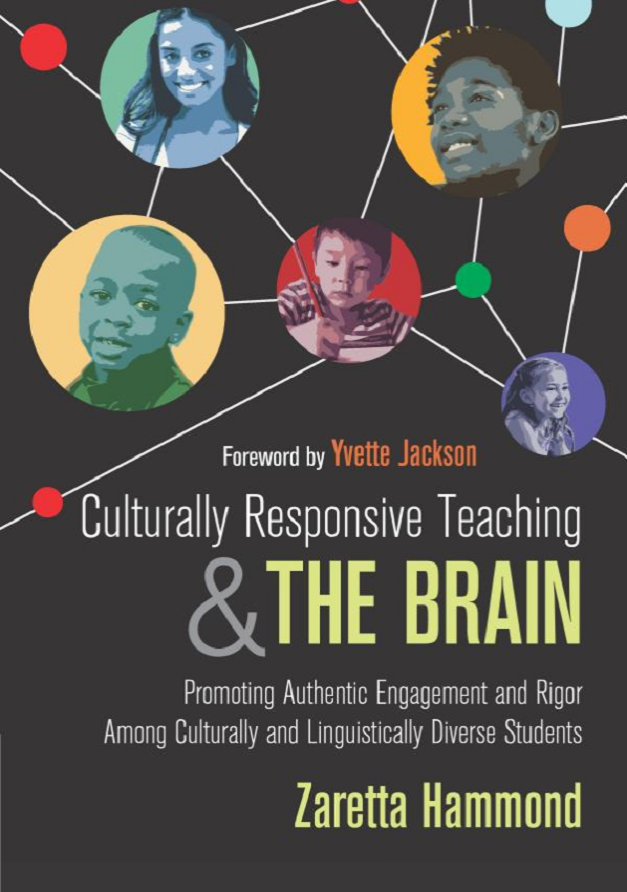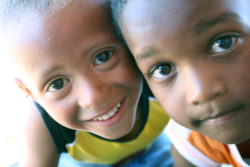
Culturally Responsive Teaching and The Brain: Promoting Authentic Engagement and Rigor Among Culturally and Linguistically Diverse Students
by Zaretta Hammond, 192 pages, Corwin, November 2014
This article contains Amazon Affiliate links. If you click these and make a purchase from Amazon, I will receive a small commission at no extra cost to you.
For eight years, I taught students who would likely be labeled “at risk.” Not all of my kids fit that description, but at least half belonged to the groups we talk about when we talk about the opportunity* gap: Students whose race, culture, home language, or socioeconomic status are not necessarily a match with what many schools teach and value. I did my best to meet their needs, to challenge them and set them up for success in life, but when I look back with the knowledge I have gained over the last few years, I know I did a crappy job.
I think about Dion, one of my seventh graders, who sat listlessly through most of my classes, whose assignments were always half-finished, who always scored low on tests, who used his cute, slow smile as a cover any time I tried to push him to get his work done. I’d keep him in at lunch and after school, let him do piles of make-up work to try to bring his grade from an F to a D, and talk to him about how he needed to change his habits. But none of it worked. All of us, his other teachers and myself, met with Dion and his mom more than once to try and figure out how to get Dion to improve.
The discussion often went like this:
“What do you think is the problem here?” from one of my colleagues.
Dion shrugged. “I’m not doing my work.”
From another teacher: “And what do you need to do differently?”
Another shrug. “Start doing my work, I guess.”
Nothing changed. Dion managed to keep his grades up just enough to move on to eighth grade. His skills never improved, his habits stayed about the same, and he went on with his life, like hundreds of others moving through that same school system every year.
If we had read Zaretta Hammond’s book, Culturally Responsive Teaching and The Brain, things could have been completely different for us, for Dion, and for so many other students in our school. This practical, insightful, and absolutely necessary book will help teachers do a better job of teaching a more diverse group of students.
A Brain-based Blueprint for Reaching Diverse Students
Culturally Responsive Teaching and The Brain is not just a “bag of tricks” teachers can pull from to help students from more diverse backgrounds do better. It is a thoughtful, holistic, brain-based approach to teaching the whole child.
By looking through the lens of neuroscience, Hammond shows us how the brain responds to various teaching approaches and learning environments, and helps us understand why, despite our best efforts, many students simply haven’t responded to the kinds of interventions many schools put in place for them. “The problem of the achievement gap won’t be solved by simply trying to motivate students of color to become more engaged learners,” she writes. “We have to create school environments that welcome their natural ways of learning and shape content so that they see its connection to their lives and funds of knowledge.”
The book is built around the Ready for Rigor Framework, four separate practice areas that, if used together, give us the tools for culturally responsive teaching. The practice areas are:
Awareness. Before teachers can truly meet the needs of diverse learners, we must develop the right mindset. This requires us to understand what “culture” really means, fully explore our own cultural beliefs and biases, and study how the brain learns.
Learning Partnerships. To succeed in school, diverse learners need to feel as if they are in partnership with their teachers. To create these relationships, we need to build trust with students, help them develop positive mindsets, and give them the language to talk about their learning.
Information Processing. Teachers need to understand how to expand students’ intellective capacity so they can engage in deeper, more complex learning. This requires teachers to learn brain-based information processing strategies common to oral cultures like metaphors, rhythmic mnemonics, and “story-ifying” the content.
Community Building. Culturally responsive teachers work to create supportive, welcoming environments, places that feel socially and emotionally safe, so that students are comfortable enough taking the risks required to stretch their brains.
Apart from being incredibly useful and clear, what’s great about this book is that it won’t make teachers defensive. Rather than attacking teachers for taking the wrong approach, Hammond simply shows us why some methods are ineffective, then explains why a different approach works better. This lack of judgment is likely to give her message a bigger reach, and to help far more teachers develop the skills they need for this important work.
We Can Do Better
Maya Angelou said, “Do the best you can until you know better. Then when you know better, do better.” I believe most teachers are doing the best they can to serve all of their students. They just don’t have enough tools. This book is without question a way to know better. I urge anyone who works with culturally diverse students, second-language students, or students who have grown up in poverty to read Culturally Responsive Teaching and The Brain. There’s no way for me to reach Dion now, but there are millions of others just like him. Now we have the tools to really change their academic paths.
Now we know better. We just have to do it. ♦

Zaretta Hammond
Zaretta Hammond is a former English teacher who has been doing instructional design, school coaching, and professional development around the issues of equity, literacy, and culturally responsive teaching for the past 18 years. To read more of her work, visit her blog, Ready for Rigor, or follow her on Twitter at @Ready4Rigor.
*Author’s note, June 2018: This post has been revised slightly since its original publication in 2015, when I used the term “achievement gap” throughout. At the time, I was not aware of the way this term perpetuates deficit thinking about some of our students. My revisions are an attempt to use language that better represents our need to reach all children in a way that works for them.
Join my mailing list and never miss another post. You’ll get weekly tips, tools, and inspiration — in quick, bite-sized packages — all geared toward making your teaching more effective and joyful. To thank you, I’ll send you a free copy of my e-booklet, 20 Ways to Cut Your Grading Time in Half. I look forward to getting to know you better!





Another important thing to keep in mind when targeting the achievement gap is the access-to-books gap that exists between low and high income neighborhoods. A 2010 study from 27 countries and 70,000 students showed that coming from a home with a lot of books adds three years to a child’s education. Unfortunately, in addition to a huge achievement gap between high and low-income students, we also have an enormous access-to-print gap. Considering the lifetime cost to taxpayers of a high school student dropping out is $127,000, putting money into the relatively low-cost investment of children’s books for the home and neighborhood library can go a long way to close that gap. I wrote more about it here: http://gettingyourkidstoread.com/2015/04/22/can-giving-away-500-books-save-taxpayers-127000/
You’re absolutely right, Joe. Thanks for contributing this.
Hey Joe,
I’m interested to read about that study. As promising as that sounds, it is much more likely that the study found a correlation, which should NEVER be mistaken for a causal relationship. It is much more likely that students growing up in homes with more books are also growing up in a wealthier family with more education which then makes it no surprise that they do that much better in school. Studies that tout such easy fixes are often misleading by sharing a catchy headline and preying on the public’s misunderstanding of correlation vs. causation.
I am teaching at-risk students from background where they are the first at this education level (teaching young adults in Denmark) and I find that a lot of what I read about kids from oral traditions might also apply to students that come from uneducated homes – from the homes where nobody reads for fun or read the paper. I am guessing that the same kinds of strategies would work with these students.
Thank you for the inside – I keep being blinded by my own upper middle class background and expecting everybody to conform to them. Thank you for once again challenging myself to facing my biases.
Teacher should enhance the brain of the students in responding some activities.
Reading all type of appropriate literature is critical to a student’s higher intellectual abilities and positive outlook on life.